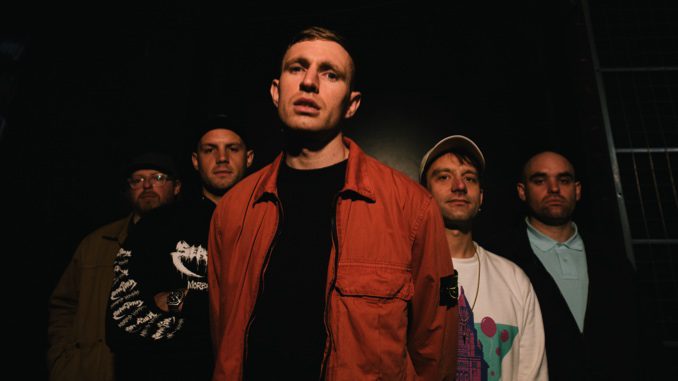For years, Paste has introduced exciting, up-and-coming artists to our readers. This is the return of The Best of What’s Next, a monthly profile column which highlights new acts with big potential—the artists you’ll want to tell your friends about the minute you first hear their music. Explore them all here.
The human brain is hard-wired to seek pleasure and avoid pain, but the give and take between the two is endlessly complicated. The pleasure of, say, a long night out at the bar brings the pain of the next day’s hangover; perhaps an even greater pain, one far more difficult to place on a medical pain scale than a headache, inspired those choices in the first place. We play one end of the spectrum against the other, driven by impulse and insistent on instant gratification, rats in an endless maze full of both pieces of cheese and electric shocks—always longing for the former and trying to convince ourselves the latter can’t hurt us, if they even exist. We are “So very easily pleased / Never satisfied / A sum of parts / Never whole / Blending in / Blending,” as Graham Sayle sings on the title track from Blending, the breakthrough second album from High Vis—as good an example of what to do with one’s pain as you’re likely to find.
Before they were High Vis, the London-based band’s members—vocalist Sayle, guitarists Rob Hammeren and Martin Macnamara, bassist Rob Moss and drummer Edward “Ski” Harper—might as well have been different people. Hardcore-punk bands were “a common origin for all of us, to a greater or lesser extent,” as Hammeren recalls, including influential U.K. acts Dirty Money, Tremors, DiE and The Smear; hardcore was “the music that started this,” Sayle agrees, though their music remains “punk in its approach.” But the anger and volatility of those times—and even of the early High Vis days, from their formation in 2016 and the 2017 release of the early, post-punk-y High Vis I and II, to their 2019 full-length debut No Sense No Feeling, which Sayle now describes as a “difficult” record that “sounds like we were as people: angry, lost and erratic”—have been largely consigned to the past, a shift accelerated by the pandemic.
“Blending started before lockdown, obviously, we were writing it,” Sayle says, recalling “just being totally isolated and just low […] and having to just change everything. And then facing up to loads of things in my life that I found problematic, and then trying to change them.” The singer started therapy and “reflected on my own life, my own upbringing, my space in the world, how I viewed myself and letting go of my concern with how people viewed me.” Meanwhile, Harper began training to become a therapist; Hammeren, too, describes the lockdown days as “a pretty major watershed for me in terms of personal growth.” “This is, essentially, me,” Sayle remembers thinking, and High Vis his way of “trying to process and deal with my whole existence.”
With these changes came new perspectives. When Sayle himself looks back now, he sees a young band in search of an identity: “It’s really easy to hide behind anger if you play in a hardcore band. You can just throw yourself into stuff and scare the audience, do whatever it is, be intimidating. That’s easy. Standing there, just having a microphone and singing is hard.” He and Hammeren now see High Vis as a band who are comfortable in their own skin, making only the music that “feels right to us,” both stylistically and emotionally. And that dedication to honesty—to accepting momentary pain as the price of growth—has affected the way they work together as a band, as well. “We’ve had some pretty fucking raw chat,” says Sayle, rather than “just teetering around, no one’s happy,” and Hammeren says that learning “how to talk with each other instead of to each other, with empathy and honesty and kindness,” has “glued us together really well,” in a time High Vis could easily have come apart. “Being in a band is like being in a relationship with four other people,” Hammeren points out—”Four fucking psychopaths,” Sayle interjects.
Where No Sense No Feeling’s punked-up opener “Choose to Lose,” which Sayle and Hammeren now see as “so hopeless” and “self-indulgently about self-destruction,” set a dark tone for that album, Blending begins with an exemplar of the band’s growth. Over Harper’s rolling drum beat, Hammeren and Macnamara unleash waves of distorted guitar that are part hardcore force, part Britpop jangle, while Sayle sees a frustrating conversation through new eyes in its singalong-worthy chorus: “Talk for hours, I hardly know ya / But I, I’m listening / I’m listening to you cry,” he insists, upholding his sense of empathy above the aggravation and breakdowns in communication that once would have dominated the conversation he depicts. Harper hammers his toms and Moss lets his bassline wander through the song’s strummy bridge, as if High Vis are luxuriating in the brighter, if still bittersweet days they’ve entered as a band.
Where their anger resurfaces, it’s targeted: “There’s a lot to be angry about here,” Sayle says of the U.K., such as the “managed decline” of Northern England examined on Blending’s “0151.” Hammeren flags this track as an early waypoint between the band’s shifting sounds, and it shows: Over a red-hot punk stomp, the Merseyside-born Sayle raises his voice for the working class—whose high-visibility workwear inspired the band’s name—barking, “We’re destitute and we’re demoralized / Our suffering disguised as pride.” Even here, on one of the album’s most incendiary songs, High Vis shine a light on the resilience and humanity at the heart of a national injustice, as Sayle sings in its galvanizing choruses, “Ghosts of the docks and the factories / Are spectres of somebody’s history / The river runs everything out to sea / But we’re still here.” The track is truth-to-power punk in spirit, yet it reaches for the rafters, with the kind of hooks to ensure the band’s message resonates far beyond the islands they call home.
If there’s a single track that stands out on Blending—in both the band’s opinion and my own—it’s “Trauma Bonds,” the record’s sonic and emotional centerpiece. Hammeren says it’s “the one that cuts the deepest for me,” while Sayle agrees it’s a—perhaps the—signature High Vis song. Written “after the news of another tragic suicide of one of our friends during lockdown” so as to take a hard look at “how the death of young people had become so normalized within our group of friends that we had become numb to it,” as Sayle explained upon its release, the song is so laden with grief, the singer finds it difficult to perform.
“It just brings me back to that feeling. It’s … weird,” says Sayle. “I want to get to a point where I can just sing it and be a bit fucking happier. But do I want to get to that point? I don’t know.” Hammeren supports his bandmate, saying that such emotionally charged songwriting “allows us an opportunity to express those feelings through our music and process them in a manageable and healthy way.” Despite the overwhelming sadness and loss weighing “Trauma Bonds” down, it’s one of High Vis’ most invigorating instrumentals, the band backing Sayle with melodic, yet serrated riffs as he longs for insight into a dire situation: “I wish I could say / Something sane to wash away / And annihilate the trauma that we save / It might just take just one / Reason inside to carry on / Or something sharp to cut these trauma bonds.”
High Vis make each of Blending’s nine tracks count, from the struggles with addiction and drug-induced escapism (much of the album is about “finding ways to escape your reality,” Sayle says) conveyed by “Out Cold” and “Fever Dream” to the bullshit-calling 1-2 punch of “Morality Test” and “Join Hands.” Closer “Shame” stands out from even such a strong pack: A chorus-pedal-heavy instrumental jam leads into some of the record’s most vulnerable songwriting, as Sayle switches up his vocal approach, softly singing, “You know me / At least you think you do / You only know the me / That I’ve let you into.” It’s a reminder that High Vis are still growing and changing, as a band and as human beings, and we’re only just beginning to find out who they are.
Blending is out now on Dais Records. Listen/buy here.
Scott Russell is Paste’s music editor and he’ll come up with something clever later. He’s on Twitter, if you’re into tweets: @pscottrussell.




